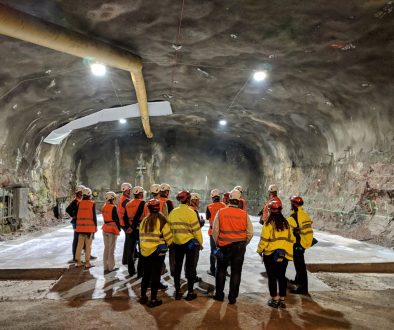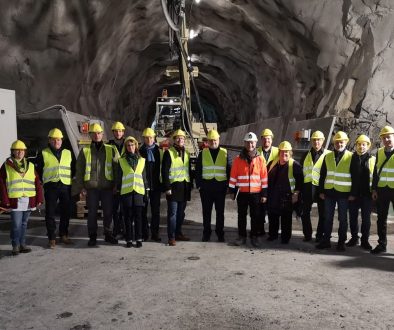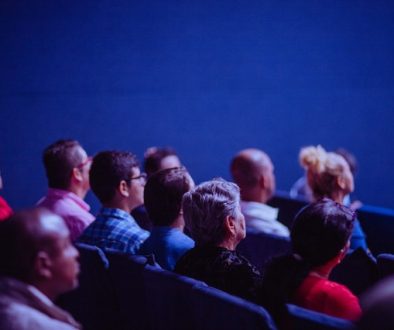Final Activity Reports Learn more
Characterisation of Underground Laboratories
Organizational characterization
Editor(s): Toni Müller
The aim of activity 2.4 is the mapping of the prevalent organizational situation of the partner’s Underground Laboratories (UL). The report contains information on the conducted surveys on the infrastructure, technical equipment and operational procedures alongside the current business models of the ULs. The gathered data was examined, compiled and summarized into this comprehensive report. Information regarding the organization and administration procedures, available infrastructure, accessibility and information on health & safety, as well as the canvas business models of the ULs are displayed in tabular form.
Geophysical Characterisation of the Uls
Editor(s): Rudiger Giese and Katrin Jaksch
The report contains the metadata of the geophysical data sets, core samples, and publications with respect to the Uls. With the help of assembled metadata, the finding of the full range of geophysical data is possible for the UL managers and users planning their activities. The recommendations for improving the metadata compatibility and linking with the existing programs like EPOS, EGDI, or ICDP are included.
Natural radioactive background characterisation of the Uls
Editor(s): Katarzyna Szkliniarz, Jan Kisiel
The report offers to the industrial and other users the full natural radioactivity characterisation of UL in Baltic Sea Region. A standard for the characterisation of a UL is introduced to allow the comparison of the Uls in terms of suitability for industrial or scientific activities. The report also contains data from the standardisation measurements and references to other Uls in the world.
Services and Support Actions of Underground Laboratories
Business Analysis
Editor(s): Taurimas VALYS, Birutė MIŠKINIENĖ, Žilvinas JANČORAS, Vytenis MOCKUS
The aim of activity 3.1. is to investigate how the underground laboratories (ULs) should be marketed as a place for innovation and who (what) is the target for this branding. The report contains the outcomes (conclusions) of Business Analysis after 5 special data collection road-shows in Germany, Sweden, Poland, Karelia (RF) and Finland. All business analysis was made by doing SWOT analysis during study visits, continuing with expert interviews (talking with existing and potential customers, business and research partners, et al.). This report contains the brief conclusions provided in BSUIN Lean Canvas, descriptions of spider diagrams and particular resumes (executive summaries) after each UL case.
Service Design: Service concepts for the ULs and a joint service offering for the network of ULs
Editors: Päivi Aro & Helena Ahola
The report describes the service concepts with the value propositions created for the ULs. Based on these service concepts of the ULs, a joint service offering for the network of ULS was created. It consists of essential and additional services. The main tool used in the service design workshops was the Value Proposition Canvas.
Underground laboratories Innovation management – A guideline for innovation management and support for innovation processes
Editor(s): Rudiger Giese, Katrin Jaksch, Pirjo Rousu, Marko Holma
The report comprises the results of questionnaires to industrial users of ULs and contains information about research collaboration, previous usage, identification of current and future requirements and possible future research areas. The report describes guidelines for implementing the site-specific services in ULs and highlight some best practice case studies.
Quality Assessment and Analysis
Editors: Rüdiger Giese, Katrin Jaksch and Marko Holma
The report presents the analysis and the current state of UL-specific services (see CSA in WP 3.3 report) and to identify and study factors that support or hinder the innovation process in ULs. Based on the general approach of the innovation platform concept and the analysis of the current state of innovation management some more specific hints to improve the innovation processes at the BSUIN ULs are given at the end of this report.
Marketing Design: Visualization of the joint service offering and the value proposition for the network of ULs
Editors: Päivi Aro & Helena Ahola
The report describes, how the joint service offering and the value proposition for the network of ULs can be visualized. There are a lot of practical ideas in order to visualize them in the report. Service design was used as an approach.
Health and Safety of Underground Laboratories
Health and Safety in Underground Environment
Editor(s): K. Fuławka, W. Pytel, M. Szumny , P. Mertuszka ,Joutsenvaara, V. Shekov, T. Bubunova
Underground laboratories provide a unique environment for various industries. They are the perfect place for developing new technologies for mining, geophysical surveys, radiation detection, as well as many other studies and measurements. Unfortunately, working in underground excavations is associated with exposure to many hazards not necessarily encountered in surface laboratories. Water inflow, gas burst, structural collapse, cave-ins, and even seismic hazards, translate into high accident rates in the underground mining industry across the globe. Many research investigations related to the development of effective risk assessment procedures are being carried out to minimise the risk of serious accidents. One of the initiatives aimed at improving the work safety in underground laboratories in the Baltic Sea Underground Innovation Network project implemented under the Interreg Baltic Sea Region Programme. This study presents the process of compiling a database on hazards within underground laboratories. Finally, a proposal for unifying the procedures for risk assessment, including methods for determining the likelihood and potential impact of unwanted events, has been developed.
Characterisation of facility improvement plans and needs have been compiled into this report highlighting the safe operation and usage of underground laboratories and the accessibility of users into the facilities. The presents the needs identified in the underground laboratory questionnaires, taking best practices from facility status and adapting the ideas for a desired level facility.
Underground laboratories working environment common standard
Editor(s): Andrus Paat, Jari Joutsenvaara
An overview report of national regulations and requirements about underground working environment. This report act as the minimum level on which the working environment must meet and is the basis to establish a common standard of underground working conditions among the participating ULs. The report is the output of WP 4.1
Review of the best practices in underground working environment development.
Editor(s): Jari Joutsenvaara, Andrus Paat
A report of collected best practices and experiences of the underground working environment from ULs involved in BSUIN project. The report is the output of the WP 4.1.
Facility design and improvement
Conceptual Laboratory Design
Editor(s): K. Fuławka, W. Pytel, M. Szumny, P. Mertuszka, S. Hanzel, M. Madziarz, J. Joutsenvaara
Underground laboratories provide a unique environment for various industries and are the perfect place for developing new technologies for mining, geophysical surveys, radiation detection, as well as many other studies and measurements. Unfortunately, working in underground excavations is associated with exposure to many hazards not necessarily encountered in surface laboratories. In result, most of the underground working, which was left i.e. after mining activities, has been abandoned or flooded with water. Nevertheless, fruitful cooperation within BSUIN project proved that there are many possibilities of further reuse of post -mining underground excavations. Such activities may be implemented especially in Polish Copper mines where both infrastructure and environmental conditions are suitable for setting up of non-mining activities. In the present document, the development of Underground Laboratory Prototype complying requirements and best practices were presented.
A working model of underground pilot facility
Editor(s): Andrus Paat, Jari Joutsenvaara
The present document is a part of the project BSUIN work package 4.1 output and it represents a working model of an underground pilot facility. Based on ULs working environment and the best practices outputs, conducted also within WP 4.1, and data gathering from other WPs, we have created a vision of how an optimal underground research facility could ideally look like.
Documented needs for future infrastructural improvements in specific ULs
Editor(s): P.Petrov, T. Bubnova, V. Shekov & K. Fuławka,
Underground laboratories provide a unique environment for various industries and are the perfect place for developing new technologies for mining, geophysical surveys, radiation detection, as well as many other studies and measurements. Unfortunately, working in underground excavations is associated with exposure to many hazards not necessarily encountered in surface laboratories. Therefore there is a strong necessity for continuous development of monitoring systems, support technology etc. to provide and ensure conditions that will fulfil all H&S requirements. Within this document, some proposals of pre-investments plans will be presented.
Underground possibilities
Underground food production
Editor(s): Henna-Maria Karjalainen, Andrus Paat
An overview report on the possibilities, advantages and examples of using underground facilities for food production and developing technologies & practices. The report is the output of the WP 2.3.
Geothermal potential, possibilities and best practices (WP2.3)
Editor(s): Marko Holma
This work summarizes the geothermal potential of closed mines and how this potential can be harnessed in places where ULs have been constructed. However, it is easier to get a hold of the concept of geothermal utilization of low enthalpy energy trapped in the mine waters of closed mines if we first take care that the
the bigger picture is also understood.
In this report, a background canvas with series of short summaries of renewable energy in general, historical perspective of geothermal energy usage, the current situation concerning the geothermal energy production in underground mines, potential of underground mines as geothermal energy sources, hydrology
of abandoned or closed mines and mine water chemistry in an abandoned or closed mine settings.
The report covers the experiences and practices in geothermal energy production in the ULs. As an example the results of the “Energy Mine” project that recently developed a concept for potential future geothermal energy
production in the Pyhäsalmi mine (Callio Lab). Additionally, the geothermal system already installed in the Castle Freudenstein, Freiberg, Germany (Reiche Zeche) is described.
Some technologies for underground space mapping (wp2.3.)
Editor(s): Anssi Rauhala, Jari Joutsenvaara
Underground laboratories and facilities alike are in need of maps and models of their facilities whether the need is for marketing, illustrations or for planning new excavations or installations of position-sensitive equipment. In this report some laser-based scanning systems were tested at Callio Lab, Finland, to find some possible technologies for the UL operators ease-of-use and cost-effective techniques for the task.
Even though simple 3D-point clouds would be easy to measure with the simplest devices the need for expert surveyors is immediate if the data is to be placed within real coordinates. Additionally, even if the data collection would be easy the data processing requires expert training before proper models can be created whether using commercially available or open-source softwares.
Experiences and best practices from the pilot case at Callio Lab, Finland: Case Well-being with Intelligent lighting in underground mine
Underground laboratories provide a unique environment for various industries. They are the perfect place for developing new technologies for mining, geophysical surveys, radiation detection, as well as many other studies and measurements. In this pilot, the underground laboratory Callio Lab, Finland, was used as a pilot site for the Well-being with intelligent lighting in the underground mine project. One of the aims was to gather experiences and feedback from the users and to gather valuable scientific data on the possibilities of intelligent, adaptive lighting for the underground facilities and the effects to the well-being to the underground workers. |



